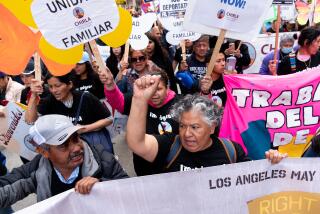Editorial: Does Disney’s new luxury hotel really need a public subsidy?
Disneyland may be the “happiest place on Earth,” but some Anaheim leaders and residents are pretty unhappy with a recent decision to give the Walt Disney Company the biggest tax break in city history to build a hotel that arguably would have been built without the giveaway.
Disney’s proposed 700-room development was one of three luxury hotel projects that the Anaheim City Council recently granted tax incentives worth $550 million over 20 years, or about $27.5 million a year. The subsidies were awarded under an Anaheim city policy, adopted last year, to encourage the development of luxury hotels (those rated four-diamond by the American Automobile Association or AAA) by allowing them to keep 70% of the Transient Occupancy Tax paid by guests for the next 20 years.
The new Disney hotel, which would be built on a parking lot next to an existing Disney resort hotel, is expected to generate an estimated $382 million in so-called bed taxes, and it would get to keep $267 million of that, according to the city.
Disney has insisted that the hotel would not be built without the incentive. Some skepticism is in order, however. The company built, and later expanded, the four-diamond Grand Californian Hotel & Spa without an incentive. It undertook an extensive renovation of the Disneyland hotel in 2012 that bumped it into the four-diamond category, also without an incentive. It wouldn’t be a stretch to think that Disney sees greater demand for luxury accommodations to go along with its record attendance, higher ticket prices and new attractions, including “Star Wars Land.”
The City Council members who voted for the tax breaks argue that Anaheim needs more luxury hotels to attract wealthier guests, who might otherwise stay in swankier digs in Newport Beach or Costa Mesa. In their view, more luxury hotels will lift room rates across the city and boost occupancy tax revenue, justifying the huge tax break companies receive for building them. But that assumes developers won’t build fancy new hotels in Anaheim without an incentive — an assumption some industry experts dispute.
The hotel market is already booming. Some 1,500 new rooms have been built or are under construction in the city. Not coincidentally, Disney is in the middle of a billion-dollar-plus expansion of the park, including the construction of “Star Wars Land,” which is certain to be a blockbuster attraction. Mayor Tom Tait, an outspoken opponent of the luxury hotel subsidy program, argued that Anaheim leaders are shortchanging taxpayers by chasing luxury hotels. He said the city would get a better return from the construction of one or two three-diamond hotels than one subsidized four-diamond property.
While lawmakers are willing to start tax incentive programs, there is rarely an attempt to outline specific goals for a tax break and then measure its success.
The fight over the Disney tax break reflects the larger questions and problems that surround tax incentive programs.
When lawmakers adopt tax breaks to encourage hotel construction, or in-state movie production, car manufacturing or any other specific activity, they are essentially picking favorites with public dollars. Why, for example, should luxury hotels get a gigantic tax break when more modest hotels do not? More than a thousand hotel rooms have been built in Anaheim in the last two years and none required a subsidy.
Incentives are often poorly targeted. Would Disney or the other luxury hotel developers have eventually built these projects anyway? If a tax break goes to a hotel — or a film production, or a company expansion — that would have happened without a subsidy, then taxpayers trade away money that could have been spent on streets, parks and other public services.
Supporters of Anaheim’s tax break argue that the city needs to subsidize luxury hotel construction to remain competitive with other large cities that offer similar incentives. (Los Angeles, for example, has subsidized hotel construction around its convention center.) But using tax breaks to spur investment often leads state and local governments to engage in an incentives arms race. There’s no better example than film tax credit programs. The states that have them — including California — have found themselves offering increasingly generous tax breaks to compete with one another (and with foreign countries) for film and television productions.
But while lawmakers are willing to start tax incentive programs, there is rarely an attempt to outline specific goals for a tax break and then measure its success. Did the subsidy create the kind of jobs lawmakers desired? Did it spur a new industry and continued economic investment, or was it a one-time boost? Did the tax break generate more revenue than it cost, and more than would have otherwise occurred organically? These can be hard questions, but the answers are essential to determining whether a tax incentive is a legitimate tool for economic development, or simply a gift to businesses. Unfortunately, Anaheim doesn’t appear to be asking them.
Follow the Opinion section on Twitter @latimesopinion and Facebook
MORE FROM OPINION
Whether View Park is a national historic place or not, things are changing there.
Grasping at straw men in the wake of the Nice massacre
This year’s Republican National Convention will be super weird and super white
More to Read
A cure for the common opinion
Get thought-provoking perspectives with our weekly newsletter.
You may occasionally receive promotional content from the Los Angeles Times.










